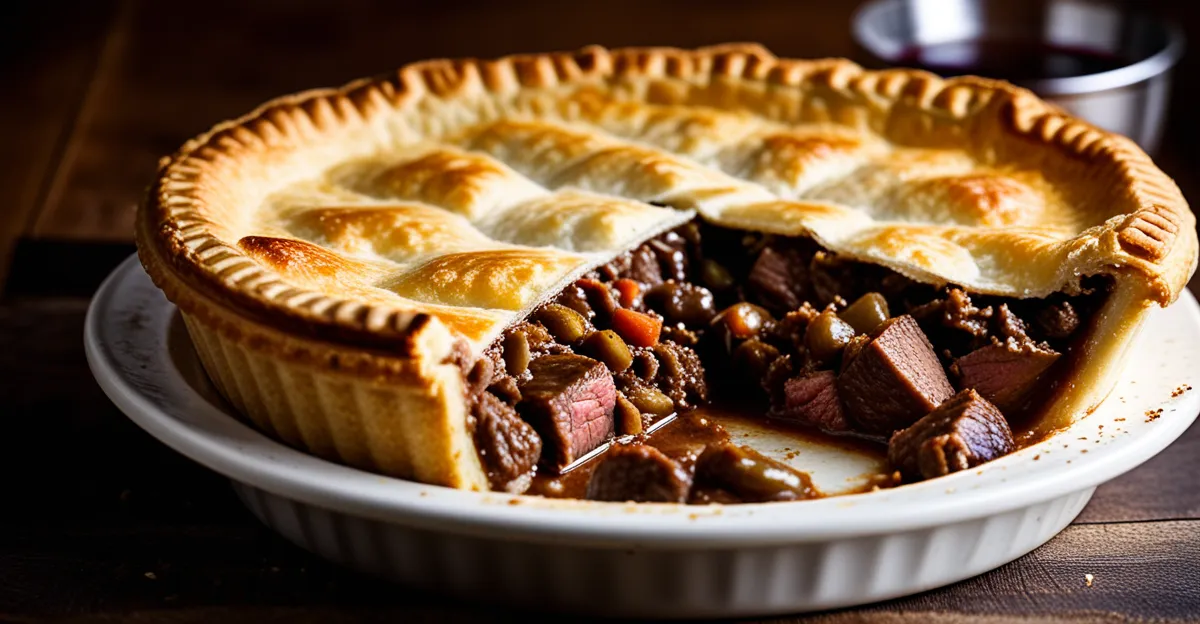Essential Ingredients and Quality Selection
Selecting the right steak and kidney pie ingredients is crucial for a pie with authentic, rich flavour. When choosing steak for pie, opt for cuts with enough marbling like chuck or blade, which maintain juiciness throughout slow cooking. Lean cuts can dry out, resulting in a less satisfying texture. The best kidneys for pie traditionally come from lamb or veal; lamb kidneys provide a delicate, mild taste, while veal kidneys offer a firm texture and robust flavour. Avoid older beef kidneys, as they tend to have a stronger, sometimes off-putting taste.
Freshness and quality of all components, especially the kidneys and steak, directly influence the final dish. Prioritize sourcing from trusted butchers or suppliers. Beef suet is another key ingredient in the crust and filling; seek fresh, white suet rather than processed or shaved suet to ensure optimal flavour and texture. Using high-quality stock, aromatic vegetables, and fresh herbs will complement these prime ingredients well.
Topic to read : What are the key ingredients for a mouthwatering beef Wellington?
Incorporating these carefully selected steak and kidney pie ingredients sets the foundation for a tender, flavourful pie that honours tradition and satisfies the palate.
Preparation and Cooking Technique
Mastering steak and kidney pie preparation begins with properly handling the meat. Start by trimming excess fat and sinew from the steak and kidneys to prevent unpleasant textures in the pie filling. Thoroughly rinse kidneys and soak them briefly in cold water with a splash of vinegar or milk to mellow the strong flavour—a key meat preparation tip for palatable results.
Also read : How Did British Cuisine Evolve Over Time?
Browning the steak and kidneys in batches over high heat is essential to develop a rich, caramelised crust. This browning locks in juices and adds depth to the flavour profile. Avoid crowding the pan; otherwise, ingredients steam rather than sear, which diminishes taste.
When assembling the pie, layering is crucial. Place the browned steak first, then the kidneys, interspersed with softened onions and herbs. This arrangement allows even cooking and melding of flavours during baking. Slow, gentle cooking after filling ensures the tenderness of steak and kidneys, avoiding toughness that can spoil the pie’s enjoyment.
Pausing to deglaze the pan with stock or wine after searing captures all the flavourful browned bits, which can be incorporated into the filling. This technique enriches the pie’s gravy, enhancing the final dish’s historic, hearty essence.
Perfecting the Pastry
Creating the ideal pie pastry is as important as selecting the right filling. For a steak and kidney pie, using either shortcrust pastry or a traditional suet crust depends on your texture preference. Shortcrust pastry offers a flaky, tender crust that crisps beautifully, while suet crust delivers rich, moist layers that complement the hearty filling.
One key to flaky pastry is handling the dough minimally and chilling it thoroughly before rolling. This prevents gluten from overdeveloping, which can toughen the crust. Incorporate cold butter or suet evenly throughout the flour to create pockets of fat that puff during baking, giving a crisp, light texture.
Blind baking the base—or partially baking the crust before adding the filling—helps avoid a soggy bottom, a common pitfall in meat pies. Use baking weights or beans to keep the pastry flat. Chilling the pie both before and after assembly also seals the pastry edges, reducing shrinkage or cracking during baking.
These pie pastry tips ensure your steak and kidney pie boasts an inviting, golden crust that holds up to the filling’s moisture and enhances every bite.
Expert-Level Seasoning and Flavour Building
Balancing steak and kidney pie seasoning is vital to elevate traditional filling without overpowering it. Classic herbs like thyme, bay leaves, and parsley provide aromatic depth, while pepper and a hint of nutmeg enhance complexity subtly. Avoid adding too much salt early in cooking; seasoning gradually preserves the gravy’s balanced flavour and prevents it from becoming overly salty.
Flavour enhancers for pie often include Worcestershire sauce or a splash of red wine added during cooking. These add umami and richness, enriching the filling’s profile without masking the natural taste of the steak and kidneys. Incorporating sautéed onions and garlic also layers flavour, marrying well with herbs and spices.
Introducing fresh herbs late in cooking preserves their aroma—adding chopped parsley just before baking boosts freshness. Some cooks cautiously use mustard or a touch of smoked paprika for a mild twist, but such ingredients should complement rather than dominate.
In brief, traditional pie herbs and spices are the foundation, and careful seasoning ensures the perfect harmony of hearty meat and aromatic notes. Experimentation guided by these principles allows for a pie seasoning blend that delights without overwhelming the palate.
Baking and Serving Suggestions
Careful steak and kidney pie baking is key to achieving a perfectly cooked pie with tender filling and golden pastry. Bake at a moderate temperature, around 180°C (350°F), to allow the heat to penetrate evenly without burning the crust. Cooking for about 45–60 minutes is typical, but monitoring for a crisp, golden top while ensuring the filling bubbles gently guarantees a satisfying result.
Resting the pie for 10–15 minutes after baking is crucial. This pause lets the gravy thicken as it cools slightly, preventing it from running when cut, and allows the filling to set, aiding in easy slicing. Without resting, the pie tends to spill juices and lose structure.
For serving steak and kidney pie, traditional accompaniments enhance the experience. Classic sides include creamy mashed potatoes, buttery peas, or minted mushy peas. Fresh seasonal vegetables also balance the richness and add colour. Some prefer a simple green salad with a tangy dressing to cut through the pie’s hearty nature.
In summary, careful baking, resting, and thoughtful serving steak and kidney pie choices ensure each bite is rewarding and honours the dish’s traditional roots.
Common Mistakes and Troubleshooting
Avoiding steak and kidney pie mistakes starts with properly managing moisture and cooking times. A common error is a dry pie filling due to overcooking the meat. To fix this, check meat tenderness early and introduce extra stock or a splash of water during cooking if the filling appears too thick or dry. Another issue is chewy meat, often caused by using lean cuts or insufficient slow cooking. Opt for cuts with marbling and cook slowly to maintain tenderness.
Pastry problems, such as shrinking or cracking, arise from overworking the dough or not chilling it enough. To prevent this, apply pie troubleshooting tips like resting the dough adequately before rolling and chilling the assembled pie prior to baking. If cracks occur during baking, patch them with extra pastry or a slurry of flour and water.
Runny gravy is often due to insufficient thickening agents or undercooking. Solutions include simmering the pie longer to reduce excess liquid or adding a cornstarch slurry to thicken the filling just before baking. Bland flavour can be remedied by seasoning gradually, layering herbs, and using flavour enhancers like Worcestershire sauce cautiously.
These fixes ensure your steak and kidney pie is tender, flavourful, and visually appealing.




